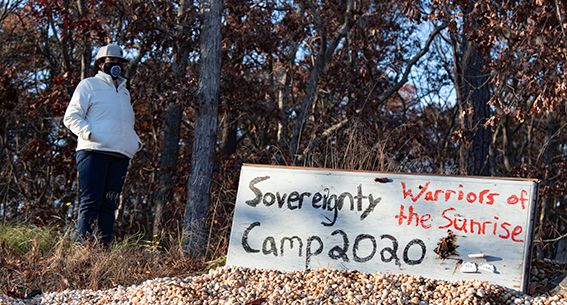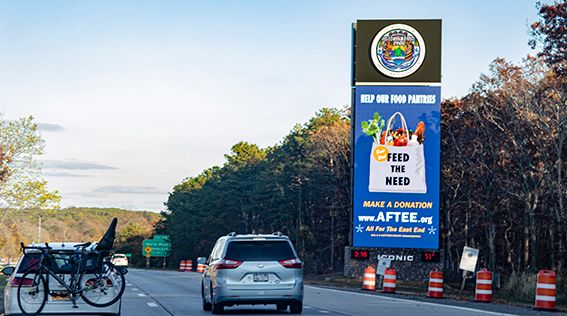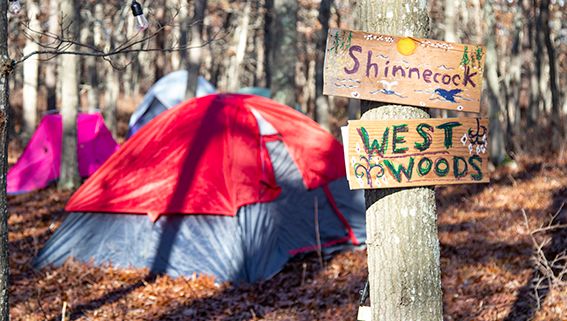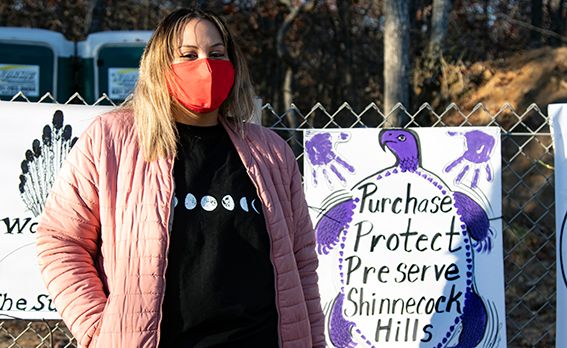
This article was written by Walker Bragman and Mark Colangelo
Southampton, New York, is the famed summer retreat of billionaires and celebrities. A two-hour drive east from New York City, mansions line its picturesque beaches and luxury vehicles parade its streets. But just outside of town, a Native American group has been staging a month-long occupation for their tribe’s economic empowerment. The protest ends today, on the Native American National Day of Mourning, when millions will be celebrating Thanksgiving.
The Sovereignty Camp 2020 is set across the Sunrise Highway from a 61-foot tall electronic billboard featuring the Shinnecock Indian Nation seal. Down the side, ads for NYU Langone Health flash in brilliant technicolor. Recently, it also featured public safety messages from Southampton Town related to COVID-19 — ad space the Nation gave free of charge. The highway, which cuts through dense woods, doesn’t have lights or any other billboards, making this one unmissable. The Nation is planning to build another sign at the campsite, but the state of New York is fighting them in court.
To the moguls nearby, the billboards are an assault on their idyllic way of life — one they are trying to tear down. To the Shinnecock, the signs are monuments asserting their continued existence in the face of generational oppression. The billboards are also about immediate survival: When completed, the structures should generate millions in desperately needed revenue for the Nation from advertisers eager for visual promotion in a spot promising maximum visibility to an affluent audience.
The conflict spotlights not merely one local property battle, but the ongoing displacement of indigenous peoples from their own tribal lands. It is a parable affiliated in popular culture with South America and the western United States — and now it is playing out in the vacation hideaway of the wealthiest and most powerful people on the planet.

“Our Cherished Way Of Life”
The Shinnecock are one of 13 tribes indigenous to Long Island — and the only one with federal recognition, which they secured in 2010. Their original territory ranged about 146 square miles — from current day Eastport to East Hampton; from Peconic Bay to the Atlantic Ocean. Since their first encounter with English settlers in 1640, their holdings have been diminished to less than 1,000 acres.
There are 1,550 Shinnecock alive today — many of them descendants of enslaved natives and Africans. About half of that population lives on a 1.3 square mile reservation that borders Southampton. The Rez, as it is called by locals, accounts for most of Shinnecock tribal holdings and is stricken with poverty.
Meanwhile, about 100 yards from the Rez is Meadow Lane, also known as “Billionaire Lane.” This seaside road is home to the exclusive Meadow Club of Southampton as well as designer Calvin Klein, KKR & Co. co-founder Henry Kravis, hedge fund mogul Daniel Och, and Apollo Global Management co-founder Leon Black. In February, a home on Meadow Lane sold for $41 million. An 8-minute drive from The Rez is Coopers Neck Lane, ranked by Zillow as the 8th richest street in America in 2015, with a median home value of $11.8 million.
From the start, the Town of Southampton and New York State sought to stop the project before it ever got off the ground. The battle has received widespread media attention, even making an appearance on The Daily Show, which took out an ad on the billboard that read, “Relax and enjoy your stolen land.”
After several stop-work orders and a cease and desist were ignored, the New York Attorney General’s office filed suit in 2019 on behalf of the state’s Department of Transportation seeking to remove the completed structure and prevent construction of the second sign. The suit alleges that the Nation did not seek proper permitting, that there are safety concerns for highway drivers, and that the Westwoods is not Shinnecock land. In May, a New York State lower court judge denied the state’s request for a preliminary injunction to remove the monument, but the battle is far from over.
Meanwhile, residents from the surrounding community circulated a petition on Change.org demanding the removal of the billboard — and the controversy has driven advertisers away, depriving the tribe of desperately needed revenue.
“As residents of the Town of Southampton, we enjoy the beauty of our town and take great pride in our environment, which offers lush woods, beautiful waterways and the quaint communities in which we live,” the petition read. “But the large illuminated billboards that are being erected on Sunrise Highway threaten to damage our cherished way of life.”
The ongoing battle prompted the Warriors of the Sunrise, a Shinnecock-led activist group dedicated to the Nation’s economic development, to organize the 26-day Sovereignty Camp. The protesters argue that the site of the monument billboards, a territory known as the Westwoods, is Shinnecock land and thus New York State’s lawsuit represents an unlawful incursion on the Nation’s sovereignty. The Nation shares this position. The encampment also has the support of groups like The Long Island Progressive Coalition, Cooperation LI, and both the Nassau County and Suffolk County Democratic Socialists of America.

“Monuments can tell a story, and that’s exactly what this is,” said Tela Troge, spokesperson for the Warriors and a tribal attorney. “It’s a monument to the Shinnecock Nation and it’s a monument to the Nation’s continued existence.”
Southampton Town Supervisor Jay Schneiderman told The Daily Poster that while he did object to the billboards when they first went up, believing them to be “out of character for the area” — a sentiment he still holds — the town was not standing in the way of their construction or operation.
“Large illuminated digital advertising displays are more typical of urban areas,” Schneiderman wrote in an email. “However, I respect the Nation’s desire for income to help address social and economic issues on the reservation. The town has not blocked the operation of the billboard or the construction of the second billboard. [New York] State believes that the billboards violate federal highway law.”
Schneiderman declined to say whether or not he felt the state’s lawsuit ought to continue.
16 Coats, 60 Bushels Of Corn And Protection
At the heart of the state’s lawsuit is a 300-year-old land dispute over territory known as Shinnecock Hills, which separates the billboard monument sites — also contested land — from the reservation itself.
The Hills was Shinnecock territory for thousands of years before settlers first arrived and “purchased” land from the natives to establish Southampton in exchange for 16 coats, 60 bushels of corn, and protection from other tribes. The partition involved two dubious transactions in 1703 and 1859. In the first, the Shinnecock relinquished ownership of the Hills and Shinnecock Neck to the town in exchange for a 1,000-year lease. In the second, the state legislature approved a transfer of the Hills to the town’s proprietors in exchange for the Shinnecock reclaiming absolute ownership of the Neck — a move that reduced tribal holdings to less than 1,000 acres.
In his book “Colonizing Southampton,” the late David Goddard, sociology professor at the City University of New York, noted that the Shinnecock had rejected similar offers from the town multiple times over the years, but faced mounting pressure in the form of continued encroachments on the land by the settlers and costly lawsuits.
There are also lingering questions about the signatures on the petition submitted to the legislature by the town. Around 1885, a dozen Shinnecock tribal members signed an affidavit alleging the signatures had been forged. Compounding those problems, Congress never authorized the exchange as required by The Federal Non‐Intercourse Act of 1790, which prohibits states and local governments from engaging in land transactions with Native American tribes without federal approval.

Efforts to reclaim the land by the Nation have thus far been unsuccessful. A 2005 suit against New York State ended a decade later with an unfavorable ruling from the 2nd Circuit Court of Appeals that remuneration would be too “disruptive” to the non-Native communities. The decision had been the latest in a string of similar rulings by the 2nd Circuit against tribes seeking to reclaim their ancestral territories. Still, the tides may be turning nationally. Over the summer, the Supreme Court ruled that much of the State of Oklahoma was situated on tribal land for the purposes of jurisdiction.
The partition of the Shinnecock Hills may affect the outcome of the current litigation over the Westwoods billboard monuments.
In his May decision preventing removal of the existing sign, New York State Supreme Court Judge Sanford Neil Berland wrote that “not only is it undisputed that the Nation owns the land in question, but there is no doubt that the Nation has owned it for many decades, if not centuries, predating most, if not all, significant development in the area.”
But in its amended complaint filed the next month, the state argued that actually, the Westwoods “is separate and apart from the Shinnecock Indian Reservation” — an argument only made possible by the partition — and “is not aboriginal or sovereign lands.”
“We Are Seriously Struggling”
Contested land ownership has hindered Shinnecock efforts to develop economically. In 2007, plans for a casino and bingo hall in Hampton Bays on a Westwoods parcel fell through after the town sued and a federal judge ruled that the Nation had lost aboriginal title to the Westwoods during colonial times.
At the time, the Shinnecock tribe was not federally recognized despite applying in 1978, and that lack of recognition presented a serious hurdle to its efforts. However, with the Nation’s federal recognition in 2010, the outlook has changed. This past September, the Nation announced that not only had the U.S. National Indian Gaming Commission approved its tribal gaming ordinance, but it had partnered with Native American gaming chain Seminole Hard Rock Entertainment and developer Tri-State Partners on plans for another casino.
But those plans are a ways off and The Rez is in desperate need now.
“Right now, [the billboard monument] is literally the only revenue that we have and it doesn’t even meet our minimum basic needs,” Warriors spokesperson Troge explained. “We are seriously struggling.”
She acknowledged that the situation is far from ideal in that the Nation must rely on revenue from some of the same forces driving commercialization and development on the east end. The billboard has featured advertisements for Rolex, BMW and other luxury brands.
“Everything about all of this is perverse,” she said.
But the reality is, 60 percent of The Rez’s population live below the poverty line according to the last census. Data compiled by TownCharts reveals that over half of the population earns less than $15,000 annually. Food insecurity, lack of basic supplies, and inadequate housing are persistent problems.
The COVID Threat
The COVID-19 pandemic has compounded the situation. The Shinnecock had to bar outsiders from their annual Labor Day Powwow at the Rez, which normally draws thousands and represents a substantial revenue source for the Nation. While Native Americans are disproportionately affected by the pandemic, the Shinnecock have been remarkably successful at containing the virus. Still, Troge said there has been a recent outbreak on The Rez linked to early voting, which could spell disaster.
“There’s a vast unmet need for a housing fund,” she said. “We have a situation where a lot of people on The Rez live in multigenerational households. Sometimes you have three or four generations living in one house so it’s almost impossible to quarantine from vulnerable members of your family.”
To her point, The Rez has a larger average household size than the rest of the state and the country as a whole, and 33 percent of families rely on a single earner.
“To make things worse, most houses have serious structural deficiencies,” she said. “Some lack plumbing, some lack heating, and it’s this widespread problem because we’re completely cut off from accessing any type of traditional capital that people would use for housing. Like, we can’t get mortgages, we can’t get home equity lines. So basically how people are building houses is like, you have to like, basically put away money from your paycheck each week or you have to max out your credit cards.”
Troge noted that there are tribal members who will be spending this winter living in tents on The Rez — and some who won’t even have that luxury.
Schneiderman, the Southampton town supervisor, told The Daily Poster that he has been working to secure a grant “to address some of the housing issues affecting a few of the elders living on the Reservation.” He also noted that he has supported “many of the Shinnecock Nation’s economic development initiatives, including the medical marijuana dispensary and the gas station.”
Asked about reparations, he cautioned that “the town would not be the proper party to discuss this. It would have to be at a federal level.”
A Debt Owed
Troge told The Daily Poster that economic development is part of a debt owed to the Shinnecock. Currently, economic development projects like the billboard account for 30 percent of the tribal government’s budget.
In the 400 years since they encountered settlers, the Shinnecock have faced genocide — outright enslavement and indentured servitude, decimation from foreign diseases like smallpox, forced assimilation through though Indian schools like the notorious Thomas Indian School of Eerie, New York and the Carlisle Indian School. That legacy of violence continues today through not only economic neglect, but continued encroachment and cultural desecration.
In 2018, a construction crew unearthed an ancient burial site while digging a foundation for a new development in the Shinnecock Hills, complete with skeletal remains and artifacts. While the Shinnecock long for their ancestors’ graves to be left in peace, there was little they could do to prevent the excavation, and the remains were removed from the site.
In September, the Southampton town board, after months of protest from tribal members, unanimously adopted the Graves Protection Act and placed a moratorium on construction in parts of the Shinnecock Hills. The move earned praise from Shinnecock Nation Chairman Bryan Polite who said it marked “a new brighter chapter in the three-hundred-and-eighty-year relationship between the Town of Southampton and the Shinnecock Nation.”
In our correspondence, Schneiderman called the act “landmark legislation.” But Rebecca Genia, a longtime Shinnecock activist and member of the Warriors, said the town’s actions were “watered-down” and took way too much work.
“For decades, we’ve been pleading with them to adopt these laws and keep the bulldozers out of our sacred hills,” she said, explaining that the the moratorium came “finally with more pressure, more public people, more allies coming together to email the town board, to call them to text them, to have personal conversations with them. We had a demonstration in January of 2020. It was freezing cold out there but 150 people showed up to stop the desecration of the Shinnecock Hills.”
Genia expressed doubt that much will change even with the moratorium in place. She noted that despite the protesters’ efforts, one home was still allowed to be constructed.

Troge said that the construction in the Hills has not stopped even now.
“They keep building. It’s horrible. It’s horrible to watch,” she said. “We’ve actively been there watching as they’re taking our ancestors’ skulls out of the ground.”
Troge said a justification often given for removal is that the remains could be from victims of MS-13 related gang violence. She said the desecrations are alarmingly common and necessitate “repatriation ceremonies” wherein the Nation repossesses the remains that have been removed, and buries them as close as possible to their original resting places. According to Genia, in the previous year alone, the Shinnecock have conducted over one hundred such ceremonies.
“I can’t explain the toll that it takes on you,” Troge added, describing having been in attendance.
The largest gravesite desecration happened in 1891 with the construction of the Shinnecock Hills Golf Club — the same Club that hosted the 2018 U.S. Open, an event from which the Shinnecock did not benefit financially except for being allowed to charge visitors for parking on their land. Untold numbers of gravesites were excavated during construction of the course. As there were no protocols for dealing with ancient remains, Genia explained, many of the bones ended up in trash cans, in people’s attics, or were swept into the golf course’s bunkers.
“These billionaires build their mansions on stolen land,” Genia said, “and play golf on our cemeteries.”
Photos by Lindsay Von Werner.
This newsletter relies on readers pitching in to support it. If you like what you just read and want to help expand this kind of journalism, consider becoming a paid subscriber by clicking this link.




